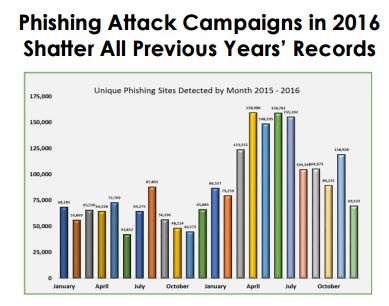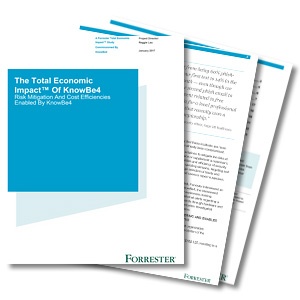 Year over year sustained growth in phishing campaigns produces yet another record number of attacks
Year over year sustained growth in phishing campaigns produces yet another record number of attacks
The Anti-Phishing Working Group (APWG) observed that 2016 ended as the worst year for phishing in history. According to the APWG’s new Phishing Activity Trends Report, the total number of phishing attacks in 2016 was 1,220,523. This number represents the highest ever recorded, and fully a 65 percent increase over 2015.

“Phishing is an attack that relies primarily on fooling people, rather than highly sophisticated technical implementations,” said APWG Senior Research Fellow and iThreat VP Greg Aaron. “For that reason, phishing remains both popular and effective. Also, the APWG’s numbers for 2106 just measure broad-based attacks against consumer brands. The numbers don’t attempt to catalog spear-phishing, which is highly targeted phishing that targets only a few specific people within a company. Truly, phishing is more pervasive and harmful than at any point in the past.”
The new report also brings new insights from APWG’s contributing members across the globe, a feature that will continue to appear in Phishing Activity Trends Reports going forward.
Axur, a Brazilian company that concentrates on protecting companies and their users in Brazil, found that fraudsters in Brazil are using both traditional phishing and social media to defraud Internet users. They are also using technical tricks to make it harder for responders to stop theses scams and filter them before they reach end users. “Criminals are re-inventing themselves all the time,” said Fabio Ramos, CEO of Axur. “We’ve seen a decrease in the numbers of regular phishing attacks - and an increase in other methods of fraud, such as malware fake services advertised through social media platforms.”
APWG member RiskIQ examined how phishing victims are fooled by phishers – not by the address in the browser bar, but by hyperlinks (which must be hovered over to even see the destination domain), URL shorteners, which mask the destination domain, or brand names inserted elsewhere in the URL.
“A relatively low percentage of phishing websites targeting a brand attempt to spoof that brand in the domain name—whether at the second-level or in the fully-qualified domain name,” says Jonathan Matkowsky, VP for intellectual property & brand security at RiskIQ. This is evidence that phishers do not need to use deceptive domains names to fool Internet users into visiting their sites.
Whitepaper Download: Forrester Total Economic Impact Study
 KnowBe4 recently commissioned Forrester to conduct a Total Economic Impact™ (TEI) study, examining the potential Return on Investment (ROI) enterprises might realize by implementing the KnowBe4 Security Awareness Training and Simulated Phishing Platform.
KnowBe4 recently commissioned Forrester to conduct a Total Economic Impact™ (TEI) study, examining the potential Return on Investment (ROI) enterprises might realize by implementing the KnowBe4 Security Awareness Training and Simulated Phishing Platform.
The resulting research paper assesses the performance of the KnowBe4 Platform. How does 127% ROI with a one-month payback sound?
At the end of the study, you will have a framework to evaluate the ROI of the KnowBe4 Security Awareness Training and Simulated Phishing Platform on your organization, and how you can leverage your end-users as your last line of defense using KnowBe4.
The value of KnowBe4 goes beyond ROI. Download the study here




